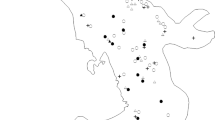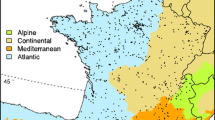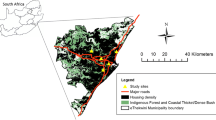Abstract
The creation of cities, towns and farms following European settlement of Australia has fragmented the original vegetation. Many native species that were previously widespread are now found only within isolated remnants of their original habitat. These relictual populations are at increased risk of decline and local extinction, so identifying the factors that determine their persistence is important for ongoing management and conservation. I compared the effects of site area, connectivity, vegetation condition and habitat resources on the presence, abundance and total number of species of butterflies and day-flying moths within 46 urban fragments of remnant vegetation in south-west Western Australia. Site area and vegetation condition were the dominant determinants of species presence: large sites with more undisturbed vegetation favoured 16 of 20 native species and only one (Geitoneura minyas) benefited from disturbance. Another nine species that were not sufficiently widespread or abundant to enable individual analysis were collectively more prevalent in larger sites. Resource quality and quantity dominated the patterns of site occupancy, consistent with habitat resources, not metapopulation effects, determining current distribution patterns. The total number of species at each site reflected the collective responses of the individual species: increasing with area and declining with vegetation disturbance. The effects of area and vegetation condition were not simply additive: disturbance had a far greater impact on small remnants. Restoration or maintenance of high vegetation condition will be essential to maintain regional species diversity and to prevent local extinctions of butterflies and day-flying moths, especially in small remnants.



Similar content being viewed by others
References
Akite P (2008) Effects of anthropogenic disturbances on the diversity and composition of the butterfly fauna of sites in the Sango Bay and Iriiri areas, Uganda: implications for conservation. Afr J Ecol 26:3–13
Atmar W, Patterson BD (1993) The measure of order and disorder in the distribution of species in fragmented habitat. Oecologia 96:373–382
Barry S, Elith J (2006) Error and uncertainty in habitat models. J Appl Ecol 43:413–423
Baz A, Garcia-Boyero A (1995) The effects of forest fragmentation on butterfly communities in central Spain. J Biogeogr 22:129–140
Beard JS (1990) Plant life of Western Australia. Kangaroo Press, Kenthurst
Beaumont L, Hughes L (2002) Potential changes in the distribution of latitudinally restricted Australian butterflies in response to climate change. Glob Change Biol 8:954–971
Blair RB (1999) Birds and butterflies along an urban gradient: surrogate taxa for assessing biodiversity? Ecol Appl 9:164–170
Braby MF (2000) The butterflies of Australia: their identification, biology and distribution. CSIRO publishing, Collingwood
Braby MF, Edwards ED (2006) The butterfly fauna of the Griffith district, a fragmented semi-arid landscape in inland southern New South Wales. Pac Conserv Biol 12:130–154
Brown KS, Freitas AVL (2004) Butterfly communities of urban forest fragments in Campinas, São Paulo, Brazil: structure, instability, environmental correlates, and conservation. J Insect Conserv 6:217–231
Burbidge AA (2004) Threatened animals of Western Australia. Department of Conservation and Land Management, Kensington
Burnham KP, Anderson DR (1998) Model selection and inference: a practical information-theoretic approach. Springer, New York
Burnham KP, Anderson DR (2002) Model selection and multimodel inference: a practical information-theoretic approach, 2nd edn. Springer, New York
Common IFB (1990) Moths of Australia. Melbourne University Press, Carlton
Connor EF, Hafernik J, Levy J, Moore VL, Rickman JK (2002) Insect conservation in an urban biodiversity hotspot: the San Francisco Bay area. J Insect Conserv 6:247–259
Dapporto L, Dennis RLH (2008) Species richness, rarity and endemicity on Italian offshore islands: complementary signals from island-focused and species-focused analyses. J Biogeogr 35:664–674
Dennis RLH (2004a) Butterfly habitats, broad-scale biotype affiliations, and structural exploitation of vegetation at finer scales: the matrix revisited. Ecol Entomol 29:744–752
Dennis RLH (2004b) Just how important are structural elements as habitat components? Indications from a declining lycaenid butterfly with priority conservation status. J Insect Conserv 8:37–45
Dennis RLH (2010) A resource-based habitat view for conservation. Butterflies in the British Landscape. Wiley-Blackwell, Chichester
Dennis RLH, Eales HT (1997) Patch occupancy in Coenonympha tullia (Muller, 1764) (Lepidoptera: Satyrinae): habitat quality matters as much as patch size and isolation. J Insect Conserv 1:167–176
Dennis RLH, Eales HT (1999) Probability of patch site occupancy in Coenonympha tullia (Müller) (Lepidoptera: Satryinae) determined from geographical and ecological data. Biol Conserv 87:295–301
Dennis RLH, Hardy PB (2004) Loss rates of butterfly species with urban development. A test of atlas data and sampling artefacts at a fine scale. Biodivers Conserv 10:1831–1837
Dennis RLH, Hardy PB (2007) Support for mending the matrix: resource seeking by butterflies in apparent non-resource zones. J Insect Conserv 11:157–168
Dennis RLH, Shreeve TG, Olivier A, Coutsis JG (2000) Contemporary geography dominates butterfly diversity gradients within the Aegean archipelago (Lepidoptera: Papilionoidea, Hesperioidea). J Biogeogr 27:1365–1383
Dennis RLH, Shreeve TG, Van Dyck H (2003) Towards a functional resource-based concept for habitat: a butterfly biology viewpoint. Oikos 102:417–426
Dennis RLH, Hodgson JG, Grenyer R, Shreeve TG, Roy DB (2004) Host plants and butterfly biology. Do host-plant strategies drive butterfly status? Ecol Entomol 29:12–26
Dennis RLH, Shreeve TG, Isaac NJB, Roy DB, Hardy PB, Fox R, Asher J (2006a) The effects of visual apparency on bias in butterfly recording and monitoring. Biol Conserv 128:486–492
Dennis RLH, Shreeve TG, Van Dyck H (2006b) Habitats and resources: the need for a resource-based definition to conserve butterflies. Biodivers Conserv 15:1943–1946
Dennis RLH, Dapporto L, Shreeve TG, John E, Coutsis JG, Kudrna O, Saarinen K, Ryrholm N, Williams WR (2008) Butterflies of European islands: the implications of the geography and ecology of rarity and endemicity for conservation. J Insect Conserv 12:205–236
Dover JW, Rowlingson B (2005) The western jewel butterfly (Hypochrysops halyaetus): factors affecting adult butterfly distribution within native Banksia bushland in an urban setting. Biol Conserv 122:599–609
Dover JW, Sparks TH, Greatorex-Davies JN (1997) The importance of shelter for butterflies in open landscapes. J Insect Conserv 1:89–97
Dover JW, Dennis RLH, Atkins L (2008) The western jewel butterfly (Hypochrysops halyaetus) II: factors affecting oviposition and egg distribution within native Banksia bushland in an urban setting. J Insect Conserv 13:487–503
Edwards ED (1997a) Castniidae and the republic. ANIC News 11:October 1997
Edwards ED (1997b) Moths in the sun. ANIC News 10:April 1997
Ewers RM, Didham RK (2006) Confounding factors in the detection of species responses to habitat fragmentation. Biol Rev 81:117–142
Fartmann T (2006) Oviposition preferences, adjacency of old woodland and isolation explain the distribution of the Duke of Bugundy butterfly (Hamearis lucina) in calcareous grasslands in central Germany. Institute of Landscape Ecology, Muenster
Fattorini S (2006) To fit or not to fit? A poorly fitting procedure produces inconsistent results when the species-area relationship is used to locate hotspots. Biodivers Conserv 16:2531–2538
Fawcett T (2006) An introduction to ROC analysis. Pattern Recog Lett 27:861–874
Fletcher D, Mackenzie D, Villouta E (2005) Modelling skewed data with many zeros: a simple approach combining ordinary and logistic regression. Environ Ecol Stat 12:45–54
Fred MS, Brommer JE (2003) Influence of habitat quality and patch size on occupancy and persistence in two populations of the Apollo Butterfly (Parnassius apollo). J Insect Conserv 7:85–98
Fry JC (ed) (1993) Biological data analysis: a practical approach. The Practical Approach Series. Oxford University Press, Oxford
Garden J, McAlpine C, Peterson A, Jones D, Possingham H (2006) Review of the ecology of Australian urban fauna: a focus on spatially explicit processes. Austral Ecology 31:126–148
Gibb H, Hochuli DF (2002) Habitat fragmentation in an urban environment: large and small fragments support different anthropod assemblages. Biol Conserv 106:91–100
Government of Western Australia (2000) Bush forever. Western Australian Planning Commission, Perth
Gripenberg S, Roslin T (2005) Host plants as islands: resource quality and spatial setting as determinants of insect distribution. Ann Zool Fenn 42:335–345
Grundel R, Pavlovic NB (2007) Resource availability, matrix quality, microclimate, and spatial pattern as predictors of patch use by the Karner blue butterfly. Biol Conserv 135:135–144
Hardy PB, Dennis RLH (1999) The impact of urban development on butterflies within a city region. Biodivers Conserv 8:1261–1279
Hill CJ (1987) Butterflies. In: Catterall CP, Wallace CJ (eds) An island in suburbia: the natural and social history of Toohey forest. Institute of Applied Environmental Research, Griffith University, Brisbane, Queensland, pp 122–125
Hogsden KL, Hutchinson TC (2004) Butterfly assemblages along a human disturbance gradient in Ontario, Canada. Can J Zool 82:739–748
Hosmer DW, Lemeshow S (2000) Applied logistic regression. Wiley series in probability and regression, 2nd edn. Wiley, New York
Kadlec T, Benes J, Jarosik V, Konvicka M (2008) Revisiting urban refuges: changes of butterfly and burnet fauna in Prague reserves over three decades. Landsc Urban Plan 85:1–11
Keighery BJ (1994) Bushland plant survey. A guide to Plant Community Survey for the Community. Wildflower Society of WA, Nedlands
Kennewell C, Shaw BJ (2008) Perth, Western Australia. Cities 25:243–255
Kitching RL, Scheermeyer E, Jones RE, Pierce NE (eds) (1999) Biology of Australian butterflies, vol 6. Monographs on Australian Lepidoptera. CSIRO Publishing, Collingwood
Koh LP, Sodhi NS (2004) Importance of reserves, fragments and parks for butterfly conservation in a tropical urban landscape. Ecol Appl 14:1695–1708
Krauss J, Steffan-Dewenter I, Tscharntke T (2003) Local species immigration, extinction, and turnover of butterflies in relation to habitat area and habitat isolation. Oecologia 137:591–602
Krauss J, Steffan-Dewenter I, Tscharntke T (2004) Landscape occupancy and local population size depends on host plant distribution in the butterfly Cupido minimus. Biol Conserv 120:355–361
Krauss J, Steffan-Dewenter I, Muller CB, Tscharntke T (2005) Relative importance of resource quantity, isolation and habitat quality for landscape distribution of a monophagous butterfly. Ecography 28:465–474
Lamont BB, Klinkhamer PG, Witkowski ETF (1993) Population fragmentation may reduce fertility to zero in Banksia goodii—a demonstration of the Allee effect. Oecologia 94:446–450
MacKenzie DI, Nichols JD, Hines JE, Knutson MG, Franklin AD (2003) Estimating site occupancy, colonization and local extinction probabilities when a species is detected imperfectly. Ecology 84:2200–2207
Maes D, Van Dyck H (2001) Butterfly diversity loss in Flanders (north Belgium): Europe’s worst case scenario? Biol Conserv 99:263–276
McCaw L, Hanstrum B (2003) Fire environment of Mediterranean south-west Western Australia. In: Abbott I, Burrows N (eds) Fire in ecosystems of south-west Western Australia: impacts and management. Backhuys, Leiden, pp 87–106
McKinney ML (2008) Effects of urbanization on species richness: a review of plants and animals. Urban Ecosyst 11:161–176
Nelson GS, Nelson SM (2001) Bird and butterfly communities associated with two types of urban riparian areas. Urban Ecosyst 5:95–108
New TR (1984) Insect conservation: an Australian perspective. Dr W. Junk, Netherlands
New TR (1991) Butterfly conservation. Oxford University Press, Melbourne
New TR (ed) (1993) Conservation biology of Lycaenidae (Butterflies). Occasional Paper of the IUCN Species Survival Commission No. 8. IUCN, Gland
New TR, Sands DPA (2002a) Conservation concerns for butterflies in urban areas of Australia. J Insect Conserv 6:207–215
New TR, Sands DPA (2002b) Narrow-range endemicity and conservation status: interpretations for Australian butterflies. Invertebr Syst 16:665–670
Newland G (2003) Literature review—urban areas and butterfly conservation. Vic Entomol 33(4):60–64
Pollard E, Yates TJ (1993) Monitoring butterflies for ecology and conservation. Chapman and Hall, London
Rosenzweig ML (1995) Species diversity in space and time. Press Syndicate of the University of Cambridge, Cambridge
Ruszczyk A, De Araujo AM (1992) Gradients in butterfly species diversity in an urban area in Brazil. J Lepid Soc 46:255–264
Samways MJ (2007) Insect conservation: a synthetic management approach. Annu Rev Entomol 52:465–487
Sands DPA, New TR (2002) The action plan for Australian butterflies. Environment Australia, Canberra
Shapiro AM (2002) The Californian urban butterfly fauna is dependent on alien plants. Divers Distrib 8:31–40
Stevens J (1992) Applied multivariate statistics for the social sciences, 2nd edn. Lawrence Erlbaum, Hillsdale
Swets K (1988) Measuring the accuracy of diagnostic systems. Science 240:1285–1293
Thomas JA, Bourn NA, Clarke RT, Stewart KE, Simcox DJ, Pearman GS, Curtis R, Goodger B (2001) The quality and isolation of habitat patches both determine where butterflies persist in fragmented landscapes. Proc R Soc B 268:1791–1796
Tscharntke T, Steffan-Dewenter I, Kruess A, Thies C (2002) Contribution of small habitat fragments to conservation of insect communities of grassland-cropland landscapes. Ecol Appl 12(2):354–363
Ulrich W (2003) Species-area relationships of butterflies in Europe and species richness forecasting. Ecography 26:365–373
Ulrich W, Buszko J (2005) Detecting biodiversity hotspots using species-area and endemics-area relationships: the case of butterflies. Biodivers Conserv 14:1977–1988
Veech JA (2000) Choice of species-area function affects identification of hotspots. Conserv Biol 14(1):140–147
Vittinghoff E, Glidden DV, Shiboski SC, McCulloch CE (2005) Regression methods in biostatistics: linear, logistic, survival and repeated measures models. Springer, San Fransisco
Wahlberg N, Klemetti T, Hanski I (2002) Dynamic populations in a dynamic landscape: the metapopulation structure of the marsh fritillary butterfly. Ecography 25:224–232
Warren MS, Hill JK, Thomas JA, Asher J, Fox R, Huntley B, Roy DB, Telfer MG, Jeffcoate S, Harding P, Jeffcoate G, Willis SG, Greatorex-Davies JN, Moss D, Thomas CD (2001) Rapid responses of British butterflies to opposing forces of climate and habitat change. Nature 414:65–69
Whittingham MJ, Stephens PA, Bradbury RB, Freckleton RP (2006) Why do we still use stepwise modelling in ecology and behaviour? J Anim Ecol 75:1182–1189
Williams MR (1995) An extreme-value function model of the species incidence and species-area relations. Ecology 76:2607–2616
Williams MR (2008) Assessing biodiversity of diurnal Lepidoptera in habitat fragments: testing the efficiency of strip transects. Environ Entomol 37:1313–1322
Williams MR (2009) Butterflies and day-flying moths in a fragmented urban landscape, south-west Western Australia: patterns of species richness. Pac Conserv Biol 15:32–46
Acknowledgments
Byron Lamont, Ian Abbott, Colin Yates and two anonymous reviewers provided helpful comments on the manuscript.
Author information
Authors and Affiliations
Corresponding author
Appendices
Appendix 1
See Table 5.
Appendix 2
See Table 6.
Appendix 3
See Table 7.
Appendix 4
See Table 8.
Rights and permissions
About this article
Cite this article
Williams, M.R. Habitat resources, remnant vegetation condition and area determine distribution patterns and abundance of butterflies and day-flying moths in a fragmented urban landscape, south-west Western Australia. J Insect Conserv 15, 37–54 (2011). https://doi.org/10.1007/s10841-010-9307-1
Received:
Accepted:
Published:
Issue Date:
DOI: https://doi.org/10.1007/s10841-010-9307-1




